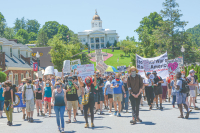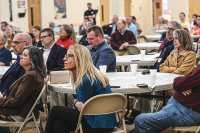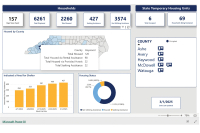Sylva board talks downtown traffic fixes
 Over the past half-century, traffic patterns in downtown Sylva have prompted a repeated cycle of complaint, remedy and return to the status quo. Now, the town is at the crest of another wave of request for change. The Sylva Board of Commissioners is considering looking into a request from some local businesses that they restore Main Street to a two-way traffic pattern.
Over the past half-century, traffic patterns in downtown Sylva have prompted a repeated cycle of complaint, remedy and return to the status quo. Now, the town is at the crest of another wave of request for change. The Sylva Board of Commissioners is considering looking into a request from some local businesses that they restore Main Street to a two-way traffic pattern.
“Safety is the underlying issue,” said Town Manager Paige Roberson. “The economic development side of it is another key point.”
Under the current pattern, traffic travels eastbound on Main Street in two lanes, with westbound traffic splitting off to go down Mill Street. The two-lane thoroughfare on Main Street encourages faster driving, and when combined with downtown’s diagonal parking spots, that can get dangerous. With cars getting bigger over recent decades, the back ends of larger vehicles often protrude into the street, meaning people driving smaller cars have to back out blind to oncoming traffic.
“It’s something we face now that we didn’t face 30, 40 years ago,” Roberson said.
The suggested change would take Main Street to a two-way pattern, slowing down traffic to reduce the chance of collision with vehicles trying to leave — and giving westbound traffic a view of the often-photographed historic courthouse. Mill Street, meanwhile, would go from two lanes to one. The closed lane would be repurposed as parking.
Related Items
“The idea is you’re driving toward the courthouse, which is one of the prettiest areas,” Roberson said. “It would help parking on Mill Street, so hopefully businesses there would benefit. Hopefully, having two-way traffic on Main Street would force drivers to slow down.”
But the concept is as far from final as it can get. The board has not cast any votes, scheduled any public hearings, looked into any costs or outlined the process for moving forward. Right now, the idea hasn’t progressed farther than a discussion at a Feb. 20 budget work session. Some local business owners had broached the subject to members of the board, who felt they deserved to at least have their ideas discussed. The concept is still in its infancy.
“On this one, the press is ahead of the process,” said Mayor Maurice Moody.
The town board of commissioners welcomes public comment of any kind at its regular meetings, held on the first and third Thursday of the month at 5:30 p.m. and 9:15 a.m., respectively. The board will schedule a public hearing before making any vote pertaining to moving forward with the concept, Moody said.
If, after hearing from the public and looking into cost, the board still wants to consider the project, it will likely hire a traffic consultant to look into variables such as traffic signals, loading zones and types of parking spaces. The town did do a similar study in 1996, but it’s likely things have changed enough in the intervening 18 years that a new one will be required, Roberson said.
“If the board wants to fund the study, we won’t contract with anyone to do the study until the new budget year in July,” Roberson said.
In the meantime, the board and the town have plenty of questions to consider. Should they stick with diagonal spaces, move to safer but less space-efficient parallel parking or use a mixture of the two? Would slower traffic be a safety blessing or a congestion curse? How much might the fix cost? Are there any better ideas out there?
“It is truly too early to predict what is going to happen,” Moody said, “other than if we do consider it, everybody involved will be included in the discussion.”









